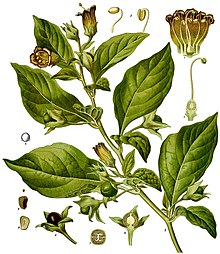Atropa belladonna

Atropa belladonna, commonly known as belladonna or deadly nightshade, is a poisonous perennial herbaceous plant in the nightshade family Solanaceae, which also includes tomatoes, potatoes, and eggplant (aubergine). It is native to Europe, North Africa, and Western Asia. Its distribution extends from Great Britain in the west to western Ukraine and the Iranian province of Gilan in the east. It is also naturalised or introduced in some parts of Canada and the United States.
The foliage and berries are extremely toxic when ingested, containing tropane alkaloids.[1][2] These toxins include atropine, scopolamine and hyoscyamine, which cause delirium and hallucinations,[1][2][3] and are also used as pharmaceutical anticholinergics. These tropane alkaloids appear to be common in the family Solanaceae, as they are also present in plants of the genera Brugmansia, Datura and Hyoscyamus, of the same family but in different subfamilies and tribes than the nightshade.
Atropa belladonna has unpredictable effects.[1] The antidote for belladonna poisoning is physostigmine or pilocarpine, the same as for atropine.[4]
Atropa belladonna has a long history of use as a medicine, cosmetic, and poison.[1][2] Known originally under various folk names (such as “deadly nightshade” in English), the plant was baptized Atropa belladonna by Carl Linnaeus (1707–1778) when he devised his classification system. Linnaeus chose the genus name Atropa because of the poisonous properties of these plants. Atropos (lit. “unturning one”), one of the Three Fates in Greek mythology, is said to have cut a person’s thread of life after her sisters had spun and measured it. Linnaeus chose the species name belladonna (“beautiful woman” in Italian) in reference to the cosmetic use of the plant during the Renaissance, when women used the juice of the berries in eyedrops intended to dilate the pupils and make the eyes appear more seductive.[5][2][6][7]
Extracts of plants in the deadly nightshade family have been in use since at least the 4th century BC, when Mandragora (mandrake) was recommended by Theophrastus for treatment of wounds, gout, and sleeplessness, and as a love potion. In the first century BC, Cleopatra used Atropine-rich extracts from the Egyptian henbane plant (another nightshade) for the above-mentioned purpose of dilating the pupils of her eyes.
The use of deadly nightshades as a poison was known in ancient Rome, as attested by the rumor that the Roman empress Livia Drusilla used the juice of Atropa belladonna berries to murder her husband, the emperor Augustus.[8]
In the first century A.D. Dioscorides recognized wine of mandrake as an anaesthetic for treatment of pain or sleeplessness, to be given prior to surgery or cautery.[9] The use of nightshade preparations for anesthesia, often in combination with opium, persisted throughout the Roman and Islamic Empires and continued in Europe until superseded in the 19th century by modern anesthetics.
The modern pharmacological study of Atropa belladonna extracts was begun by the German chemist Friedlieb Ferdinand Runge (1795–1867). In 1831, the German pharmacist Heinrich F. G. Mein (1799–1864)[10] succeeded in preparing a pure crystalline form of the active substance, baptized atropine.[11] [12]
